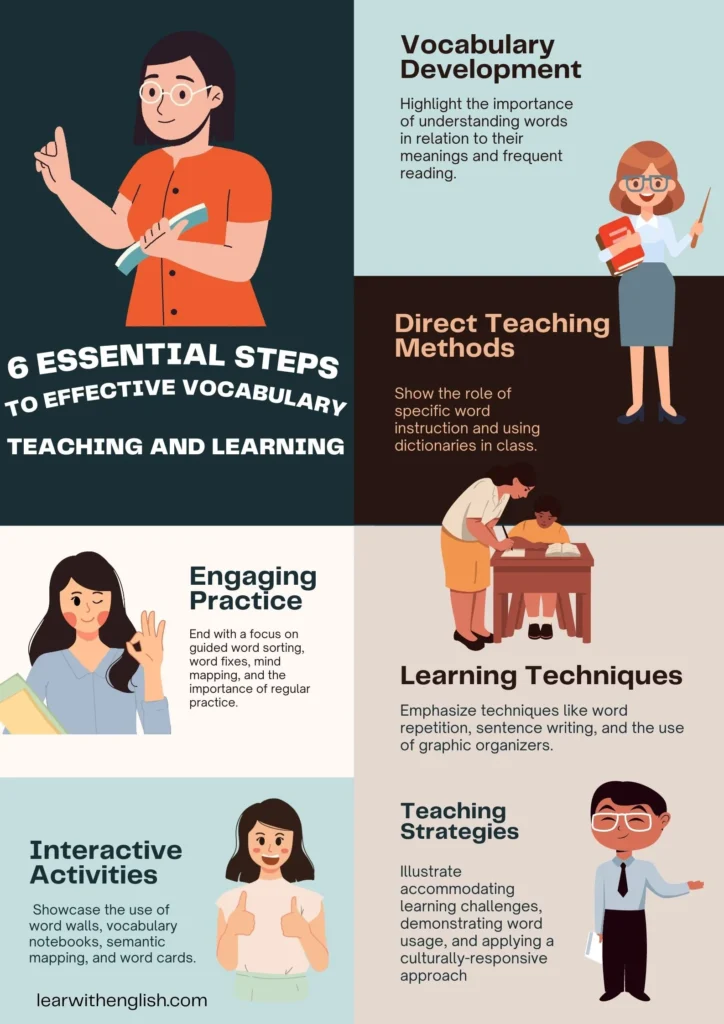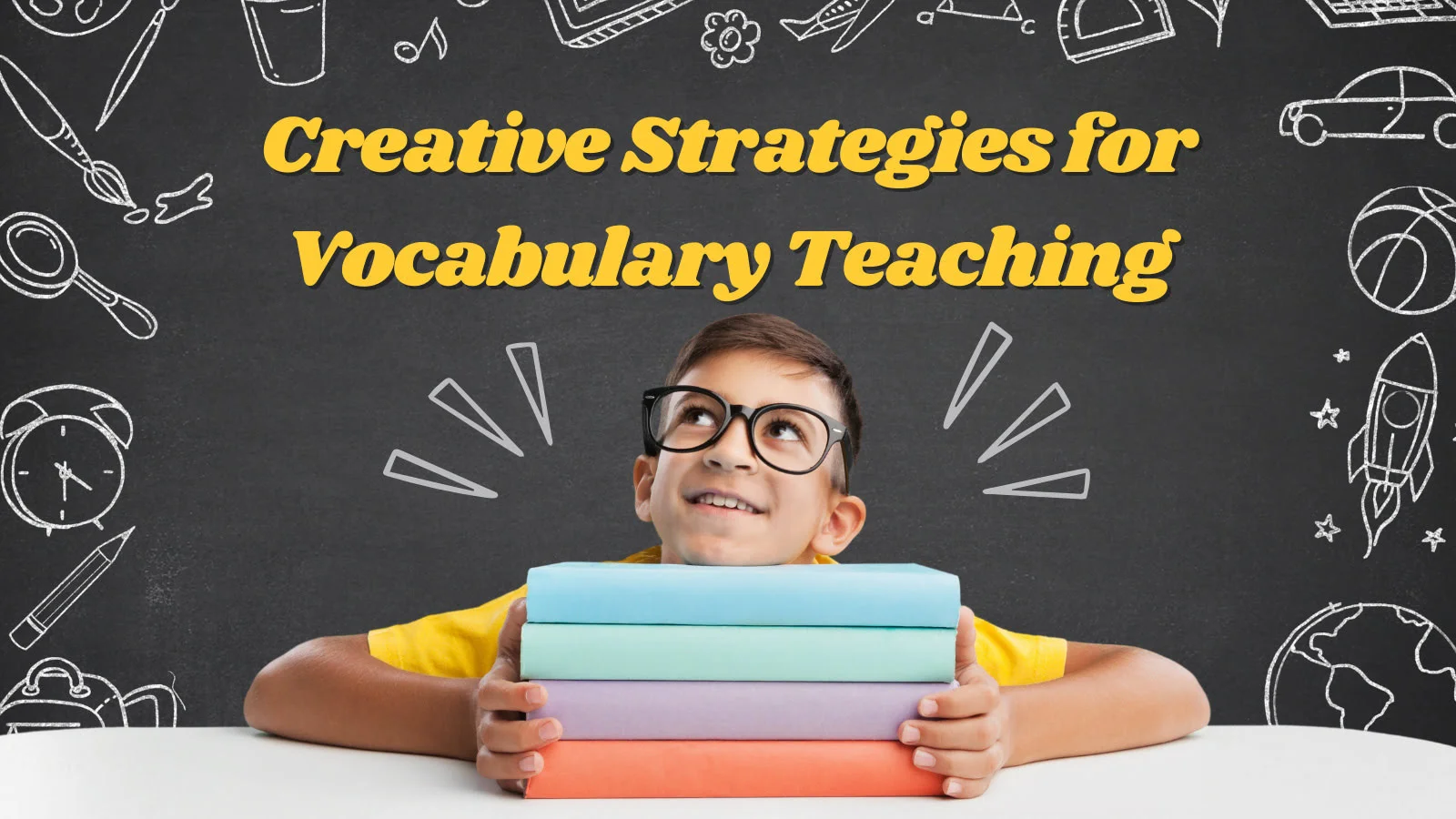Hello and welcome, fellow language enthusiasts! Today, we’re diving deep into the art of vocabulary teaching. Why, you ask? Because mastering vocabulary is like holding the golden key to academic success.
You see, words are the building blocks of communication, the tools we use to express ideas, ask questions, solve problems, and absorb new information.
Can you imagine trying to excel in school without a solid vocabulary? It’s like trying to build a skyscraper with a handful of bricks!
But hold on, let’s not sugarcoat it – vocabulary development isn’t a walk in the park. It’s a complex process filled with challenges.
From the sheer number of words to learn to the nuances in meanings and usage, the task can feel like navigating a labyrinth.
But hey, who doesn’t love a bit of adventure? So, buckle up and get ready to explore some creative strategies to make vocabulary teaching not just effective, but also a whole lot of fun!
How Vocabulary Knowledge is Developed
So, how exactly does vocabulary knowledge sprout and grow? Well, it’s all about understanding the words and their meanings and then applying them in the right context.
Think of it like learning to play a musical instrument – you need to know the notes, but you also need to know when and how to play them to create beautiful music.
Now, let’s get into the nitty-gritty of vocabulary development. There are a handful of teaching strategies that are, in my humble opinion, the bee’s knees!
Specific Word Instruction
First up, we have specific word instructions. This is the bread and butter of vocabulary teaching. It’s all about providing clear definitions, using words in sentences, and explaining the subtleties of word meanings.
The goal is to help students grasp not just the what (the word itself), but also the how (its usage in context).
Wordplay Activities
Next, we have wordplay activities. Who said learning can’t be fun? With activities like crossword puzzles, word searches, and anagrams, students can build upon previously learned words, while having a blast! It’s like sneaking vegetables into a tasty dish – the learning happens, but it’s hidden in the fun!
Frequent Reading
Encouraging frequent reading is another excellent strategy. When students dive into the world of books, they naturally boost their word knowledge and language development. It’s like taking a journey through a land filled with words, where every page turn is a new discovery.
Using the Dictionary and Sentence Usage
In our toolbox of strategies, let’s not forget the good old dictionary. Using a dictionary and encouraging sentence usage in class participation helps students understand the meaning and application of words. Think of it like a GPS for navigating the world of vocabulary.
Cognate Awareness
Cognate awareness is a fantastic tool, especially for students learning English as a second language. By highlighting similar words in English and other languages, we can help students bridge the gap between the familiar and the new. It’s like having a friendly tour guide in the exciting world of language learning.
Prioritizing Speaking Skills and Storytelling
Lastly, making speaking skills a priority and reading stories to students can enhance their vocabulary and comprehension. Because, at the end of the day, words are tools for communication, right? So, let’s encourage our students to use them, to express themselves, share their thoughts, and weave their own stories.
Effective Vocabulary Learning Techniques
Alright, friends, now that we’ve explored how vocabulary knowledge develops, let’s dive into some strategies that can make this learning process even more effective. These techniques are all about enabling quick comprehension and recall. So, let’s get to it!
Exposing Students to the Same Word Multiple Times
First off, let’s talk about exposure. You see, familiarity breeds understanding. By exposing students to the same word multiple times, we can help them grasp its meaning and usage more effectively.
It’s like revisiting a favorite vacation spot – each visit gives you a deeper understanding of the place.
Providing Word Definitions and Sentence Writing
Another key strategy is providing word definitions and encouraging sentence writing. This is a two-pronged approach – the definition provides clarity, and the sentence writing allows for practical application.
It’s like learning to swim – first, you need to understand the motions, and then you need to jump in the water and give it a go!
Using Graphic Organizers
Now, here’s a tool that can make learning new words a breeze – graphic organizers. These visual aids can be used to map out the meaning, synonyms, antonyms, and usage of new words. It’s like having a blueprint for a word – everything you need to know at a glance!
Fostering Independence and Learning from Mistakes
One of the most valuable lessons we can teach our students is to be independent learners and to see mistakes as opportunities for growth.
In the realm of vocabulary learning, this means encouraging them to discover new words, experiment with usage, and not be afraid of getting it wrong sometimes. After all, aren’t some of the best discoveries made through happy accidents?
Incorporating Technology
In this digital age, how can we forget about technology? There are numerous apps and online resources that can make vocabulary learning interactive and fun.
From digital flashcards to vocabulary games, technology can be a great ally in our quest for vocabulary mastery.
Encouraging Regular Practice
Last but not least, regular practice is the key to vocabulary retention. Just like any other skill, the more you practice vocabulary, the better you get at it. So, let’s encourage our students to make vocabulary learning a part of their daily routine.
Creative Strategies to Improve Vocabulary Teaching
Now we’re getting to the really fun part, folks! Let’s talk about some creative strategies that can make vocabulary teaching a more exciting and effective experience.
The key here is to switch things up, keep it fresh, and most importantly, take the student’s perspective. Ready? Let’s get creative!
Taking a Student’s Perspective
First things first, we need to walk a mile in our students’ shoes. By understanding their learning challenges and accommodating them, we can make vocabulary teaching a much more enjoyable and fruitful experience.
Be imaginative, Think of it like adjusting the recipe of your favorite dish to cater to different taste preferences. The essence remains the same, but the experience is personalized!
Demonstrating Word Pronunciation and Usage
Next up, let’s not forget the power of demonstration. By pronouncing words correctly and using them in sentences, we can provide a clear model for our students to follow.
It’s like giving them a live demo of a product – it just makes things so much easier to understand, don’t you agree?
Applying a Culturally-responsive Approach
Finally, let’s talk about the importance of being culturally responsive. By incorporating words and phrases from various cultures and making language instruction inclusive, we can ensure that all students feel seen and heard.
It’s like adding various spices to a dish – it not only enhances the flavor but also celebrates diversity.
Using a Word Wall
Imagine walking into a room with a vibrant wall covered with words, each word standing out with its unique color and design. That’s a word wall for you! A dynamic, visually engaging tool that can significantly boost vocabulary learning. It’s like having a Pinterest board of words right in your classroom!
Creating a Word Wall
Just like a gallery showcases various pieces of art, your word wall should display a diverse range of words. And not just any words, but those that are visually prominent and instantly grab attention. Think of it as your students’ word museum, where they can explore and learn new words every day.
Adding New Words Regularly
Of course, to keep the intrigue alive, you need to update your word wall regularly. And why not make it even more interesting by including pictures, synonyms, and antonyms? It’s like adding new exhibits to your museum, ensuring there’s always something new to explore.
Enhancing Word Understanding
A word wall isn’t just about showcasing words. It’s also about enhancing word understanding through categorization and synonyms. It’s like organizing the exhibits in your museum by themes, making it easier for your students to navigate and understand the connections between different words.
Creating Vocabulary Notebooks
Let’s switch gears and talk about vocabulary notebooks. They’re like personal diaries but for words. Imagine giving your students a resourceful place to jot down new words, their meanings, and their reflections. Sounds exciting, right?
Providing Vocabulary Notebooks
So, how do you start? Simple! Provide your students with notebooks dedicated solely to vocabulary learning. It’s like gifting them a personal journal where they can chronicle their word-learning journey.
Encouraging Writing
Next, encourage your students to not just write the new words and meanings, but also synonyms, antonyms, and sentences. It’s like encouraging them to write their own stories, with each word playing a unique character.
Promoting Reflection and Practice
Finally, use these vocabulary notebooks to promote reflection and language practice. Allocate specific writing periods where students can reflect on their learning and practice the new words. It’s like giving them dedicated “me time” with their words.
Connecting Word Meanings with Semantic Mapping
Last but not least, let’s dive into the world of semantic mapping. Think of it as creating a mind map but for words. It’s like plotting a roadmap where each word is a destination, connected to other destinations through the relationship routes.
Using Semantic Maps
Start by using semantic maps to display relationships between words and phrases. This can be a fun and interactive activity where students can visually see the connections between different words.
Involving Students in Map Creation
Next, involve your students in creating these maps. Let them add related words, creating their web of word connections. It’s like letting them chart their word adventure on the map.
Introducing Challenging Words
Gradually, you can introduce more challenging words for vocabulary growth. This would be like adding new, unexplored destinations to their word map, increasing the thrill of their word-learning journey.

Making Word Cards
Now, let’s talk about the magic of word cards. Imagine these little power-packed cards, each carrying a keyword, its definition, and its usage. They’re like mini flashcards of information, ready to make your vocabulary lessons exciting and interactive.
Creating Word Cards
To begin, have your students create their own word cards. It’s like handing them the canvas to paint their word art. They can include keywords, definitions, and usage, making each card a comprehensive word-learning tool.
Utilizing Word Cards
Once the word cards are ready, you can use them for various activities like sentence construction and peer collaboration. It’s like playing a fun word game, where each card holds the potential to construct a new sentence or spark a new discussion.
Supporting Language Development
Word cards can also be a great tool for supporting English language development and reading comprehension.
They serve as handy reference guides that students can revisit anytime to refresh their memory or deepen their understanding of the words.
Encouraging Reading Comprehension
Next, let’s delve into the realm of reading comprehension. It’s a vital skill that ties closely with vocabulary building, almost like two sides of the same coin.
Facilitating Class Discussions
Start by facilitating class discussions about books. It’s like hosting a book club right in your classroom, sparking lively debates and enriching conversations.
Incorporating Phonics
Next, incorporate phonics into your teaching. It’s a proven method for sound mastery and vocabulary building, serving as the building blocks of language learning.
Providing Grade-Appropriate Books
Make sure to provide grade-appropriate books for comprehension and vocabulary expansion. It’s like curating a personalized book list for each grade, ensuring the content is challenging yet accessible.
Engaging in Reading Aloud Activities
Lastly, engage students in reading-aloud activities in a supportive setting. It’s a great way to boost their confidence and improve their pronunciation and reading fluency.
Using Visuals and Situations
Finally, let’s explore the power of visuals and situations in vocabulary teaching. Think of them as the secret ingredients that can add a dash of fun and creativity to your lessons.
Utilizing Visuals and Flashcards
Start by utilizing meaningful visuals and flashcards for word association. It’s like painting a vivid picture in your students’ minds, helping them connect the words with their meanings more effectively.
Incorporating Word Detective Activities
Next, incorporate word detective activities during reading. It’s like turning your students into word detectives, challenging them to uncover the hidden meanings and usage of words in a text.
Encouraging Creative Drawings
Encourage your students to create drawings and connections to new words. It’s like inviting them to illustrate their own word stories, making the learning process more personalized and enjoyable.
Combining Visuals and Auditory Learning
Lastly, combine visuals with auditory learning to accommodate different learning styles. It’s like creating a multi-sensory learning environment where students can learn the way they learn best.
Using Word-Learning Strategies
Next, let’s shift our focus to word-learning strategies. These are the nuts and bolts of vocabulary learning, the methods that help us dissect words, explore their meanings, and master their usage.
Breaking Down Words
A significant strategy involves breaking down words into meaningful parts. This involves understanding prefixes and suffixes, the little elements that hold significant clues about a word’s meaning and function. It’s like being a word archaeologist, carefully piecing together parts of words to reveal their full story.
Encouraging Exploration
Next, encourage your students to ask questions and explore word meanings. Make your classroom a safe space for curiosity, where every question is a step towards greater understanding. Remember, the journey to vocabulary mastery is filled with questions, and every question deserves an answer.
Promoting Reflection and Practice
Lastly, promote reflection and practice of new words for mastery. Think of it as a rehearsal for a big performance. The more your students practice, the more confident they will become, and the more easily they will remember and use new words.
Additional Vocabulary Activities
Now, let’s delve into some additional vocabulary activities. These are the fun extras, the sweet cherries on top of your vocabulary teaching cake.
Guided Word Sorting
Begin with guided word sorting for word categorization and understanding. It’s like organizing a word party, where each word finds its group and makes new friends.
Word Fixes
Next, introduce word fixes as an engaging activity for identifying word usage errors. It’s like being a word doctor, diagnosing and fixing word usage problems.
Mind Mapping
Lastly, engage your students in mind mapping as a visual tool for word connections and associations. It’s like drawing a word constellation, connecting stars of words and phrases to form meaningful patterns and relationships.
Conclusion
Vocabulary teaching is a vast and exciting field, filled with numerous strategies and techniques.
It involves understanding the meaning and usage of words, exploring various teaching methods, applying effective learning techniques, and using creative strategies to make the learning process engaging and productive.
The journey might be challenging, but the rewards are immense. Remember, each word your students learn is a step towards greater language mastery, better academic performance, and a richer understanding of the world.
Keep exploring, keep experimenting, and keep inspiring your students in their vocabulary-learning journey.

